Rio Open looks to drive tennis momentum in Brazil
- Published
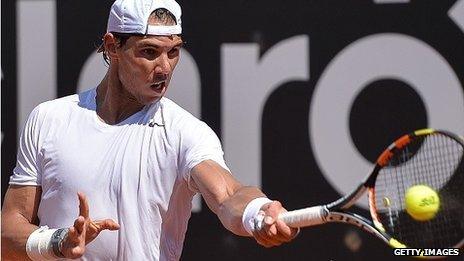
Reigning 2014 Rio Open champion Rafael Nadal is defending his title
Tennis in Brazil faces a challenge in taking on the might of football, but organisers of the Rio Open tournament being held in the city this week believe the sport is set for expansion in the country.
Having returned for a second year, the open is the biggest tennis tournament in South America, and is the only combined men's ATP World Tour 500 and women's WTA International competition in the region.
"It is already raising the profile of the sport in Brazil and Latin America," says tournament director Luiz Carvalho, who is also on the Rio 2016 organising committee for the Olympic Games and Paralympic Games tennis events.
Encouraging
Historically, Brazil has not been a "mature market" for major global sporting events, but the successfully run football World Cup, and attraction of the forthcoming Olympic and Paralympic Games, have moved the country up the hosting league table.
As such, Mr Carvalho says he wants the tournament to grow year-on-year until it becomes - while not an actual Grand Slam - the principal tournament of the region, in the way that the US Open is in North America.
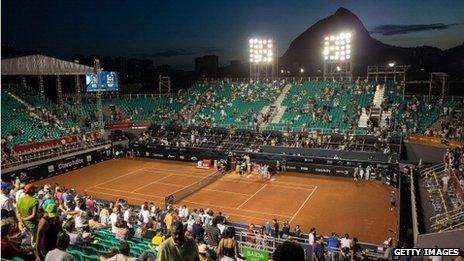
The centre court with Sugar Loaf Mountain in the background
"As our profile grows, we will attract more people to the event, which we hope will in turn encourage people to take up tennis."
And the number one men's seed at the Rio Open, Rafael Nadal, thinks the city could step up to the next rank of ATP event, and host a 1000 Masters.
"The South American region - an area where they really appreciate the sport - these countries are developing and getting more prepared to host big events," he says.
"I believe that the moment to host a bigger event in South America has arrived. I would like to see the ATP offering that opportunity in the near future."
'High-profile coverage'
Mr Carvalho says ticket sales for the clay court tournament are up roughly 20% on last year, with six out of 11 playing sessions sold out.
The 33-year-old says spectators have come from across the continent, not just Brazil, with holiday visitors to the Rio Carnival - held in the city earlier this week - also attending.
Reigning holder Nadal is joined by his countrymen David Ferrer and Tommy Robredo as seeds two and three, and the men and women's playing fields also include a number of home and regional favourites.
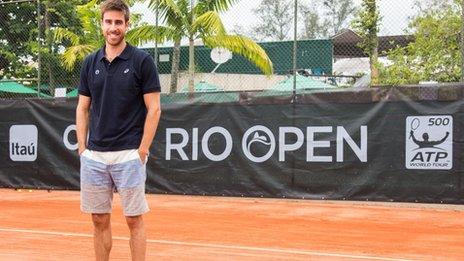
Tournament director Luiz Carvalho is a former professional player
The winners of the singles events pick up $343,000 (£223,000) each and the doubles winners $101,310, with $1.5m total prize money.
The event, held at the private Rio Jockey Club in the shadow of Sugar Loaf Mountain, is produced by sports promoters IMX, who say they have a long-term commitment to hosting the tournament.
"We are getting high-profile coverage on TV and the front of magazines - the more we market the sport, then more people will consume and play tennis," says Mr Carvalho, a former pro circuit player who reached a world high position of 868 in 2000.
Networking opportunities
He says that as well as being a sporting and social event, the tennis tournament also serves as an important networking venue, with the upmarket Corcovado Club on the site offering hospitality facilities for 1,000 people.
"Our sponsors and VIPs can get together to do business around the tennis," says the 33-year-old. "Many chief executives of big firms also play tennis, so we have them attending too."
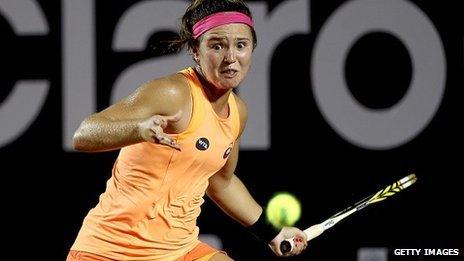
A number of Brazilian players are competing at the event
Headline sponsor is Claro, a Mexican telecoms group operating across Latin America, and other big name backers include Rolex, Xerox, Samsung, Peugeot, Asics, and Corona beer.
Major Brazilian backers include communications firm Embratel, bank Itau, postal service Correios, airline TAM, plus others.
"There is always room for more sponsors, but we are more than satisfied," says Mr Carvalho. "We had very few multi-year sponsors last year, but have had a 90% renewal from last then, which shows we are going in the right direction."
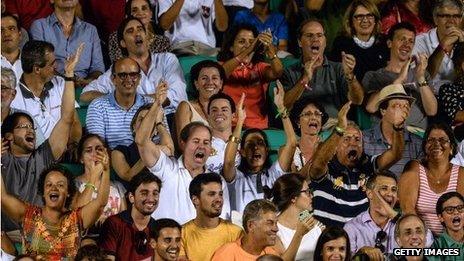
Six of the 11 tennis sessions are sold out
Nadal's participation is his first return to action since his Australian Open quarter-final defeat to Tomas Berdych. Given his attraction with the crowds, how much of a problem would it be if he does not go all the way to the final?
"It is true that the more Rafa plays, the more buzz he creates," says Mr Carvalho. "He is one of the top of his sport... but an upset would be ok for us.
"The tournament is not dependent on him. We have more to offer than one player."
Tickets cost from 25 reais to 510 reais (£5.75 to £117), with half-price options for students and the elderly. There are nine courts; five match courts - including a 6,200-seater showpiece mini-stadium, and four practice courts.
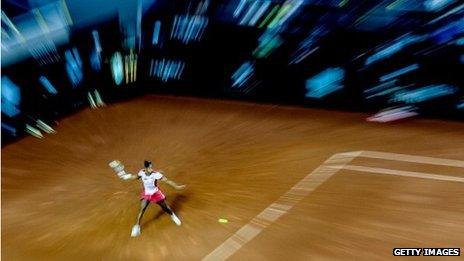
It is hoped momentum from the Open can be carried into the Olympic Games
"We think tennis is for everyone, and have priced our tickets to cover all sections of society, although we do realise that tennis is more high-end sport," says Mr Carvalho.
"But we have tickets for the less fortunate, it is only towards the end of the week, towards the finals, that tickets are more expensive. We feel the prices, for what is on offer, are correct."
Meanwhile, TV deals have been signed with Globo-subsidiary SporTV, ATP Media and IMG.
Mr Carvalho hopes that the tennis momentum will be continued during the 2016 Olympics and Paralympics.
"Next year will be another great opportunity to grow the sport, and will be a further expansion into the public consciousness," he says.
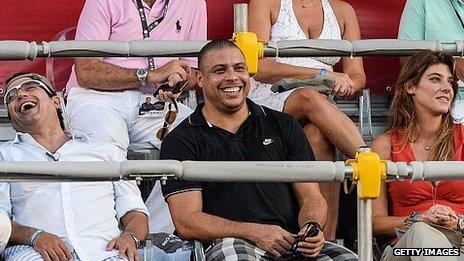
Football legend Ronaldo was a spectator at the 2014 event
"It will leave a fantastic legacy, with a 10,000-seater centre court. We don't have many proper tennis facilities to hold big events, so possibly after the Olympic Games we can hold more big tennis events."
In the same way that China went from hosting two to 10 ranking tennis tournaments after the 2008 Beijing Games, it is hoped the Olympics can create demand for more major contests in Brazil.
Also, Mr Carvalho says having the Olympic tennis complex could help Rio secure an ATP 1000 event.
As well as the showpiece Centre Court, the Olympic Tennis Centre will comprise Court 1, a temporary structure with 5,000 seats, and Court 2, which will have 3,000 temporary seats but whose court will remain after the games.
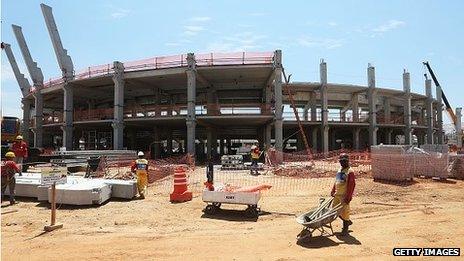
Construction work is progressing on the 2016 Olympic tennis centre
There will also be seven outside courts, each with 250 temporary seats, plus six practice and warm-up courts.
Meanwhile, 250 Olympic Games tennis staff, covering everything from catering to security, are attending the Rio Open to see how to run a major tennis event.
"The Olympic Games are just around the corner, and the [football] World Cup has shown we can confidently hold big sporting events," says Mr Carvalho.
"We will have all the top top tennis players here; Nadal, Djokovic, Federer, Murray, Sharapova, Williams, and that can only help promote the sport."